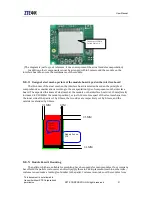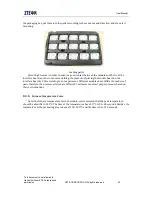
User Manual
This document is not allowed to
transmit without ZTE Corporation
’s
permission
©ZTE CORPORATION All rights reserved
17
Table 3-13 Audio interface signal definitions
Classification
No.
Definition
I/O
Description
Remarks
AUDIO
37
MIC_N0
Input Receiver on the host
Differential input
36
MIC_P0
Input
Receiver on the host
35
MIC_P1
Input
Receiver on the earpiece Differential input
34
RECN
Output
Speaker on the host
Differential output
33
RECP
Output
Speaker on the host
32
EAR_L
Output
Speaker on the earpiece
Single-ended output
3.1.14
Network signal indication
The RSSI_LED is driven at high level.
---Power-on status: the LED turns off;
---Network searching status: the LED blinks at 3Hz;
---Idle status: the LED blinks at 1Hz;
---Traffic status (call, data): the LED blinks at 5Hz.
The output status of RSSI_LED PIN is defined according to the software protocol. The RSSI_LED PIN is
a general I/O port with the output driving capability 4mA.
3.2
Module’s power consumption
It describes the module’s power consumption under each status:
Table 3-14 MG2639_V3 (GPRS) power consumption
Status
Frequency
Rx. power Min.
Average
Max.
Remarks
Power-off
15uA
VBAT=4.0V
Sleep
2mA
Standby
24 mA
Call
GSM850
240mA
EGSM900
240mA
GSM1800
180 mA
GSM1900
175 mA
Network
searching
78mA
3.3
Reliability characteristics
The module’s reliability testing items include: High/low temperature operation, high/low
temperature storage, thermal shock, alternating temperature humidity, etc. The test results must
conform to the industrial requirements. See the module’s working temperature in the table below:






























